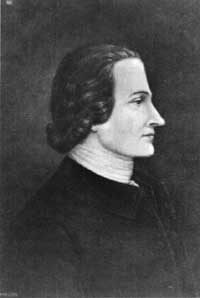







Biographical Sketches
|
GEORGE TAYLOR Pennsylvania |
 George Taylor | |
| ||
When Taylor was about 20 years of age, he indentured himself and emigrated from northern Ireland, where he had been born in 1716, to Pennsylvania. He began as a laborer and then became a clerk at Warwick Furnace, in Chester County, and within 3 years rose to bookkeeper-manager of nearby Coventry Forge, another enterprise of his employer. In 1742, the year after the latter died, Taylor acquired his business when he married his widow; she bore him a son and daughter.
In the mid-1750's Taylor moved northeastward to Bucks County, where he and a partner leased Durham Furnace, about 2 miles south of the Northampton County line and 10 miles south of Easton. Apparently after 1763 Taylor lived much of the time at or near Easton and acquired property there. In 1768 his wife died; he subsequently sired five children by his housekeeper out of wedlock. The year of his wife's death, he built a home about 15 miles west of the city on a 331-acre tract he had purchased the year before. In 1771 he leased most of the land out as a farm, and 5 years later sold the house and land.
Taylor had begun his public life in 1747, when he took a commission as a captain in the Chester County militia. In 1761 he was appointed as justice of the peace for Bucks County, but devoted most of his energies to Northampton County, which he served as justice of the peace (1764-75) and representative in the colonial legislature (1764-70). In 1774 Taylor, a political moderate, became a member of the Northampton County committee of correspondence. The next year, he attended a provincial Revolutionary convention, was elected to the provincial assembly, served on the council of safety, and became a colonel in the Bucks and Northampton County militias.
In July 1776 the Pennsylvania assembly selected Taylor as one of its new Delegates to the Continental Congress. His only noteworthy action there was signing the Declaration. The next January, however, he and fellow signer George Walton of Georgia negotiated a peace treaty with the Six Indian Nations (Iroquois) at Easton, Pa., but Congress did not ratify it. In March the voters of Northampton County elected Taylor to the new Supreme Executive Assembly of Pennsylvania, but illness and financial difficulties restricted his participation to only 6 weeks, at the end of which he retired from public life.
By this time, Taylor's Durham Furnace was turning out grapeshot, cannonballs, bar shot, and cannon for the Revolutionary army—for which Taylor was ill-compensated. In 1778 the State dispossessed him of his lease on the Durham Furnace, owned by the Philadelphia Loyalist John Galloway and confiscated by the State. Taylor then moved to Greenwich Township, N.J., and leased Greenwich Forge, which he operated until his death at the age of 65 in 1781. The year before, his health failing, Taylor had returned to Easton and leased a home. Originally buried in the yard of the German Evangelical Lutheran Church at Easton, his body was later moved to the Easton Cemetery.
Drawing: Oil, 1912, by Laura J. Schneider, probably after George T. Pool, Independence National Historical Park.
 |
 |
http://www.cr.nps.gov/history/online_books/declaration/bio48.htm
Last Updated: 04-Jul-2004